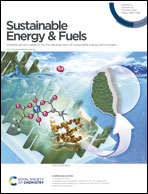Nitrogen and iron codoped porous carbon polyhedra for effectively confining polysulfides and efficiently catalyzing their conversion in lithium–sulfur batteries†
Abstract
Effectively confining lithium polysulfides (LiPSs) and efficiently catalyzing their conversion represent a judicious approach to the preparation of high-rate, long lifespan lithium–sulfur (Li–S) batteries. Herein, an Fe-containing zeolitic imidazolate framework Fe-ZIF-8 is used as a precursor to synthesize a Fe–N–C polyhedron composite that shows a high specific surface area of 1459.3 m2 g−1, a large pore volume of 1.037 cm3 g−1 and a high nitrogen content of 7.29 at%. Benefiting from the high surface area and polarity of the carbon matrix, the Fe–N–C polyhedron composite can effectively adsorb and confine LiPSs. The S@Fe–N–C based electrode with a high sulfur loading of 72 wt% shows a high initial specific capacity of 1296 mA h g−1 at 0.1C and can retain a capacity of 450 mA h g−1 after 500 charge–discharge cycles at 1C, corresponding to a low fading rate of 0.068% per cycle. In contrast, a low capacity of 345 mA h g−1 is observed for the S@N–C reference electrode even after only 200 cycles. Moreover, the Fe–Nx–Cy sites within the S@Fe–N–C electrode can also efficiently catalyze the redox conversion of LiPSs during the charge–discharge process, leading to a much higher reversible capacity of 1178 mA h g−1 at 0.1C, as compared with the 626 mA h g−1 for the S@N–C electrode. These results support the approach to the preparation of N-doped porous carbons with catalytically active M–Nx–Cy (M is transition metal) sites for high-rate, long-lifespan sulfur cathodes for Li–S batteries.



 Please wait while we load your content...
Please wait while we load your content...